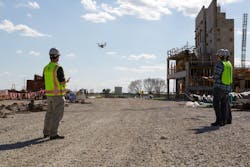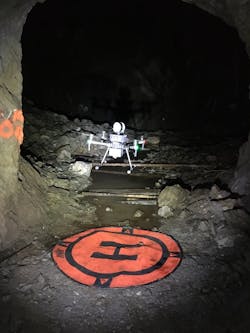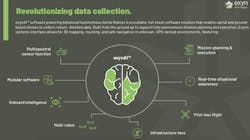AI takes flight
Five years ago, 3D Robotics introduced what it heralded as “the world’s first smart drone.” Dubbed Solo, this quad unmanned aerial vehicle was powered by twin 1-GHz computers. Since then, suppliers have been pushing drone technology to meet users’ demands for more intuitive and responsive data collection and flight.
An example of where the technology has been heading lately can be found in Ann Arbor, Mich., where researchers at the University of Michigan last year developed what they claimed is the first visual simultaneous localization and mapping (SLAM) microprocessor integrated into a drone camera to help a robot navigate its environment.
At the same time, drone makers and software developers are rolling out niche products for specific jobs and industries, partly to tap markets in which industry leader DJI isn’t so dominant. AirFusion, Skyspecs, and Sterblue focus on infrastructure and wind turbine inspection;
Ware on warehouse inventory automation; Accuware’s Dragonfly is a visual positioning system; ABJ Drones makes task-specific sensors; and VHive’s software allows swarms of drones to work in tandem.
There is also a slew of drone hardware and software producers that has come out with solutions that use the word “autonomous” in their marketing. “Autonomous drones aren’t unique,” says Michael Blades, a Vice President with the business consulting firm Frost & Sullivan, based in San Antonio, Texas. “Automation is driving the market, gradually.”
However, most “autonomous” drones that can operate without pilots or in GPS-deprived areas are still being programmed for flights and tasks. San Francisco-based AutoModality, for example, develops applications for use cases, like bridges, agriculture, and mining. It recently devised an app for high-rise curtain wall inspection and has tested an app to help drones fly inside a warehouse, says Aaron Singer, the company’s CEO.
AutoModality’s products rely on its AMROS operating suite and Perceptive Navigation robotics vision platform, which enables the drone to maneuver assets precisely and in close proximity. “We can track exactly where the drone is, and localize the data,” says Singer.
While he’s “comfortable” with his company’s app for indoor flight, “it still needs to be improved,” with quicker ways to learn and respond to complex indoor environments. “We’re pretty close to perfecting this.” Singer thinks that mapping a drone’s location will get easier as artificial intelligence and sensors evolve.
Switzerland-based Flyability just opened its first U.S. office in Denver. Its small (15.7-inch) Elios 2 drone is encased in a cage that protects the robot from collisions. Marc Gandillon, Flyability’s Marketing Manager, says that collision tolerance is actually better than collision avoidance for operating drones in tight spaces like mines. In January, the company entered into a partnership with Pix4D to accelerate the growth of indoor 3D modeling in confined spaces.
This technology, though, isn’t cheap. AutoModality charges between $10,000 and $25,000 per year to license its software. And Flyability’s Elios 2 runs around $33,000 in the U.S.
Going alone
What many drone users crave, and what a growing number of suppliers are striving to deliver, is full autonomy, which is a robot equipped with a processing unit with computer vision and machine learning to make its own decisions. That includes turning itself on and off, deciding what to fly over and record, and when to return home.
Right now, autonomous outdoor flight is, essentially, illegal under Federal Aviation Administration rules that require a drone to be piloted and visible within the pilot’s line of sight. But autonomous drones are permitted for indoor flying.
“This technology is still in its early days,” says Michael Oldenberg, a spokesman for DJI, which doesn’t have an autonomous drone on the market, but does offer robots with 360-degree sensing capability.
Skanska USA Building, whose fleet includes 25 drones and 30 certified pilots, uses aerial robots for site analysis, tracking a jobsite’s vehicular flow, logistics, and phasing. It hasn’t tried autonomous flight yet, but has had some success flying piloted drones indoors in tight spaces, says Oliver Smith, Skanska’s Southwest Region Director of Innovation and VDC.
Smith observes that drones tricked out with Vision Positioning Systems and collision avoidance still are limited. “I can fly all day inspecting elevator shafts, but for other spaces it’s challenging using a drone, especially if the sensors require a certain amount of light.” Skanska often flies its DJI drones in “tripod” mode, which throttles the robot to give the pilot more control.
Design-build firm Clayco has 30 drones and 35 pilots. Tomislav Žigo, AIA, LEED AP, the firm’s Vice President of VDC, thinks avoid-detect technology is “getting better” and that the biggest obstacle for drone use continues to be data bandwidth and processing power. So far, Clayco hasn’t flown indoors, partly because it hasn’t had a reason to, but also because Žigo isn’t confident yet that drones with detection programming and sensors are ready yet to fly around “dynamic” construction sites with people and equipment moving around.
See Also: No labor. No infrastructure. No problem.
Drones that think
Clayco “is a risk-averse company,” says Žigo. And the construction industry in general is usually more of a follower than leader on testing new technology. But AEC firms might want to keep an eye on what’s going on with autonomy, “which we think is a bigger deal than we give it credit for,” wrote the website Dronerush.com last December.
AI-enabled autonomous drones are already in use by other industries. One such product is the Aertos line, from Digital Aerolus, whose software, according to that company’s CEO Jeff Alholm, was built on a model of the human brain to be predictive instead of reactive. Aertos also has a “TouchandGo” feature that lets the drone get close to a structure for inspection without crashing into it. Digital Aerolus isn’t pursuing the building construction sector, but its commercial drones are being used for infrastructure inspection.
Construction is among the sectors that Boston-based Neurala serves with its AI-powered system whose “Brain Builder” software facilitates visual inspections. In January, Neurala formed a collaboration with the drone service provider AviSight to identify defects in critical infrastructure for customers who require a complete solution for drone-based inspections, including Beyond Visual Line of Sight (BVLOS) operations.
Exyn Technologies, a startup incubated at the University of Pennsylvania’s Grasp Lab, has raised $20 million in investor capital to further develop and expand the technology for its Advanced Autonomous Aerial Robot (A3R), which Exyn brought out in 2018.
Exyn claims that its proprietary exynAI software provides drone users with full autonomy, which the company’s CEO Nader Elm says means that the robot doesn’t rely on any infrastructure, such as GPS, markers, beacons, or motion capture systems; does not require prior information about its environment to execute a mission; and doesn’t need persistent communication with its ground-control system.
Exyn’s 3D LiDAR-based SLAM system allows the robot to track geometric features in its environment to estimate its relative changes in position and orientation over time. It combines that ability with optimization techniques that refine its local map quality in order to navigate safely and generate a digital twin of the environment.
“Our greatest technical challenge was enabling the robot to understand where it is located and what it sees around it,” explains Elm. He adds that a “fundamental tenet” of Exyn’s systems is that they react dynamically to changes in the environment to be able to re-plan their missions in real time as that environment changes or as the drone learns more about its surroundings.
Exyn Technologies is one of the few systems providers that specifically target the construction industry. A drone equipped by A3R can be set up anywhere on a construction site and navigate that site autonomously. It can build maps and collect data of the area it scans (even in low-light conditions), and transfer data to a cloud for BIM model comparisons and project report generation.
“The cost of no data or poor-quality data is a trillion-dollar problem in construction,” says Elm. By using A3R, construction firms “can improve the documentation process, and benefit from lower acquisition costs, more frequent and higher-quality data.”
But Exyn Technologies—which declined BD+C’s request for pricing information or construction-related use cases—has some work to do on the marketing side. None of the AEC firms contacted for this article had heard of the company or its platform.
Jeremiah Karpowicz, Executive Director for Distributed Communications, which publishes Commercial UAV News, says he’s always suspicious about “first” claims by any drone or software supplier. But Karpowicz is quick to acknowledge that the technology continues to get better. “It’s gotten to the point where drones are being adopted into companies’ workflows,” he says.
Skanska’s Smith adds that price isn’t necessarily an impediment to using drones. “We’ve been looking at thermal drones—which can cost up to $40,000—for exteriors, and it calculates that these are worth the cost.”
A communications tool
Drones are still controversial. The hottest debate currently, says Karpowicz, is over FAA’s proposal to require all drones have remote identification. The agency has shown a willingness in the past to adjust its regulations to accommodate expanded drone use, either through waivers or rule changes. Regulations that prevent flying beyond the pilot’s line of sight, or that limit flying over people, are expected to become more lenient over time, say industry watchers.
Clayco’s Žigo would like to see drones that are fully autonomous within compliance with FAA regulations. He’s also eager for drones with more data bandwidth and processing power to make captured images “actionable” sooner. Such combinations would give Clayco the luxury of monitoring the progress of construction and documenting underground work and installation. And if a drone could stay in the air for a couple of hours (a pipe dream at the moment when most drone flights last 10 to 20 minutes), that would greatly enhance the robot’s utility as a construction tool, Žigo posits.
Smith would like to see drones that integrate more smoothly with other platforms like AI, and with software for photo recognition and data analysis.
Both agree that, right now, drones are good communications tools that provide consistency and quality imagery that can be shared with all stakeholders on a project.
Smith says that Skanska has found that drone information is actually more reliable than that from other sources. The information comes in handy when Smith’s team works with the firm’s design group, as well as its advanced visualization group to develop 3D models, VR, and AR for clients.



